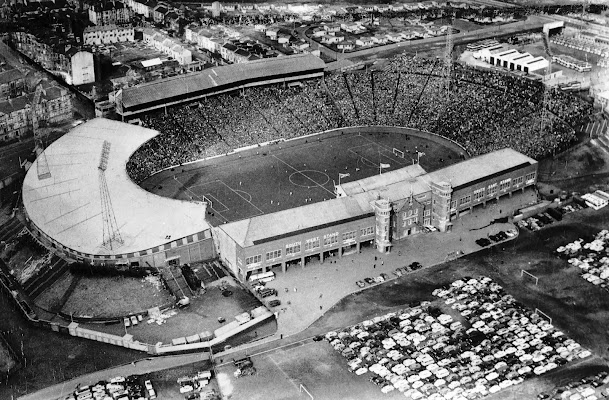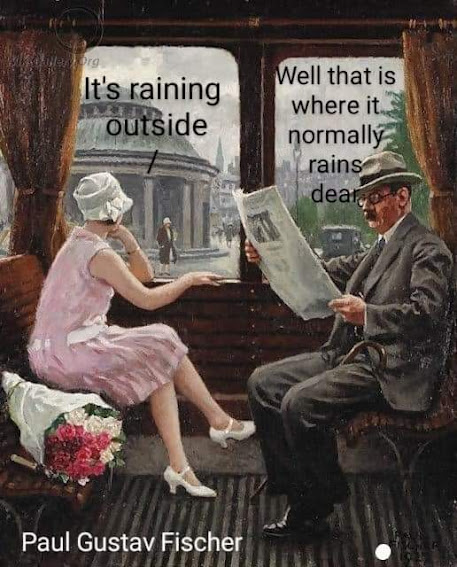For some reason which I can now no longer recall, I began to talk to myself about being at Hampden Park in 1970 for the Scotland v England game. What got me onto this I forget but the experience of Hampden in 1970 is not one to forget easily.
Today the football world is littered with glamorous football stadia, before the fires and tragedies that brought about a much needed reconstruction for safeties sake not all stadiums were glamorous. Places like Muirton Park Perth, the home of St Johnstone, for instance contained the only full sixed pitch outside of Hampden Park. The surrounding ground was very much an ancient, crumbling second division affair. Brockville Park, where the Falkirk team displayed or not their talents was called by some 'The Black hole of Falkirk.' A pleasant enough ground for lower division crowds but problematic for anything above 5000.
Hampden Park itself was where the Scotland team had played since the beginning of football under the Queens Park side who still called it home. A large bowl where the 'Hampden Roar' was unequalled anywhere else. Not that the Scottish 'Blazers' would have considered anywhere else as worth noting at the time. Both at the end of the second world war and shortly afterwards the ground recorded attendances of over 148,000. No ground in Scotland, or indeed the rest of what is laughingly called a 'United Kingdom' could equal this.
This vast expanse contained a football pitch with a running track around it, while the terraces were comprised of what can be called 'grit,' held together and edged by wooden short beams. which did not always remain in place. Stairways, usually unoccupied, ran down from top to bottom ensuring some form of access. Crash barriers, or should that be, 'Crush Barriers,' were installed aplenty around the terracing. On one of Glasgow's rare rainy days the ground could easily turn into a quagmire. The slopes that comprised exits were soon bringing back Somme memories to ex-servicemen of a certain generation. The terraces themselves were damp, clean shoes were never an option in these circumstances.
As an example of a game from that time I mention one I attended, the 1970 Scotland England game. We left Waverley Station on a passenger train especially designated for football fans. A train comprising old coaches, somewhat run down, and set aside for the drunken hooligan element British Rail expected. I was not sure why an international crowd would resort to drunken hooliganism but there you go, British Rail took no chances. There was no trouble, little comfort, I vaguely remember standing but not if we stood all the way there. It was mostly quiet in our coach, and I suspect the others, and we arrived at Queen St Station, Glasgow and somehow made our way to the ground. We must have travelled by what was then called the 'Blue Trains,' as that was how we returned to Queen St after the game.
Phil Richards Class 303
We encountered one problem at Hampden, one of us four had no ticket. Browsing around outside the ground looking for a tout we encountered a small huddle of lads surrounding one man. He was attempting to divest himself of the crowd while nearby a gentleman with clearly no connection to this chap hung about. Understanding that tickets were somewhere in the crowd our boy plunged in to barter. The totally innocent man nearby nodded, and a ticket was produced for the exchange of £1/10/-. 30 bob for a ticket! £1:50 in today's money! However, please note that official tickets for this game only cost £1 at the time. Add to this that the SFA indicated after the game that 137, 500 small cardboard tickets were handed in at the game, while only 135,000 official tickets were printed! Not a bad days work for someone.
Our tickets invited us to clamber up the not quite dry slopes into our section of the ground. There we awaited the appearance of our mate who's ticket bore a different colour and gate to ours. In the distance to our left, we saw him appear and begin to make his way towards us. The ground was quite empty at the time and he had no difficulty passing through, or over the separating fences.
As at all games at the time we stood in between two barriers. We remained far enough from the one behind in case it broke and fell on us, yet not to near the one in front, so if that gave way we fell on them. Practical requirements at the game in those far off days.
As it was the crush was great. Next to us stood a 'Rob Roy McGregor' type, beard and bunnet and all. He was confused by our group one of who called on Scotland with an English accent, caused by being brought up there, while unknow to Rob Roy another supported England with an Edinburgh accent but not out loud. We spent much time moving in the crowd as such crowds constantly move. Our main aim was to keep between out English accented Scot and Rob Roy. This broke down however, when Colin Stein, through on goal, was sent over the knee of the England centre half! The entire crowd yelled 'PENALTY!' and reached forward. Quite how the ribs did not break I will never understand. The Dutch referee responded as such Dutch referees always did in those situations, he ran away! No penalty was given, though it ought to have been, and we all stood attempting to breathe properly while breathing fire at the Dutchman. With aching ribs and Rob Roy to contend with this was not easy.
The game finished as a no scoring draw, only the second in such meeting since 1872. Of course I had to be there! Tsk! I mean I had to be at the 1970 game, not the 1872 one.
At the end we joined the crowds heading down the slopes, these now in a much worse state after the crowds had marched over them. We waited while most had moved before joining them and at the bottom fought our way through those heading towards awaiting buses. We naturally had to go the other way for the 'Blue Trains.' Outside the ground a heaving mass of men, nearly all men, pushed through one another, all knowing the unwritten laws of such crowd situations.
Two years previously we had been heading in the other direction towards the bus, to our right a gentleman dressed in the usual uniform of overcoat of the time, was indicating to the entire crowd coming towards him that they had to get out of his way. In his alcoholic stupor he could not work out that by moving to his left a few feet and the throng would carry him home, if that is he was facing the correct direction. We let the throng carry us on that occasion, this time our throng headed the other way until we were stopped beside a police horse slavering at both ends. Here police control was in force, one long line of stragglers moved, then another, having avoided both ends of the horse we soon progressed to the train and back into the city centre.
Now it was simple thing to get on an Edinburgh bound train, however, the crowd was queuing up way outside the station so instead we decided to await a later train and refreshed ourselves in Glasgow pub.
Glasgow pubs have always had a reputation, not always deserved. Pubs everywhere produce bad behaviour, not just Glasgow ones. The late 60s and 70s were not a good time for pubs however, the two main breweries 'Scottish Brewers' and 'Tennent Caledonian,' were intent on producing some of the most bland pubs known to man, and the beer to go with it. This pub, the name escapes me but it has probably changed anyway with time, was close by and quite crowded. It must have been after 5:30 or nearer 6 pm by the time we entered, obtained our lager and found a seat. We sat there filling time amidst the hubbub of noise, suddenly, on a table two tables down from us, an empty beer glass fell over. Silence! All looked around, no-one spoke, a hand reached out and reset the glass, all turned away and suddenly the hubbub returned and life continued.
Then we ventured out, walked through the dark, damp streets to the station, caught a train, another long compartment coach, and headed up the slope back to the Waverley.
Today's wealthy, soft, well provided for fan would not be able to cope in such circumstances. Digital tickets, online booking, seats that they ignore and stand up throughout a game, no pie from the stall, instead almost a Takeaway meal, and now they consider bringing beer back into the grounds. Train travel, along with a large 'Carry oot,' on a luxury electric train or perhaps driving in your own car to fret about the cost of parking when arrived is the other option. No more fearing those kids who offer to 'protect your car' for money. A softened 'Nivea' smothered generation would not survive football in the days of yore. I wonder sometimes how I managed it.

.jpg)

















